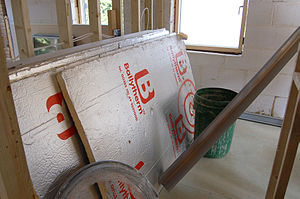| Rockwool Thermal insulation, scanned @ 1600dpi; Type Roxul RXL 80. (Photo credit: Wikipedia) |
Insulation Facts
- Insulation is measured by R value. The greater the R-value, the greater the insulation power of the insulation.
- The US department of energy recommends an R-value of R-49 for the attics of homes in most states.
- If you live in south Florida, Texas, or California then R-38 is typically all you’ll need.
- Most regional building codes for new construction require a minimum of R-19 in walls and floors.
Three Types of Insulation
Insulation comes in more forms than the pink roll you see on television. The three main types are:
Blown-In Insulation. This type of insulation is the easiest to install and is usually the ideal choice for upgrading your home. Essentially, insulation ingredients are fed into a blower and then it’s forced into the necessary spaces. This type of insulation is usually made of cellulose, rock wool, polyurethane foam, or fiberglass. Cellulose, made of recycled newspaper treated with a flame retardant, is the most popular choice.
Blanket Insulation is probably what you’re most familiar with and is typically used in new construction. It comes in rolls where it can easily be laid onto floors and ceilings and inserted into walls. It’s made of rock wool or fiberglass. Easy because it doesn’t require professional installation.
| Polyisocyanurate (rigid) insulation boards (Photo credit: Wikipedia) |
The drawback to this type of insulation is that it is flammable and composed of an ingredient that isn’t degradable or recyclable. Both mineral wool and cellulose are environmentally friendly. Though cellulose is flammable unless treated with a flame retardant.
Where Do You Insulate?
Attics are the primary place people think to insulate. The recommended minimum amount of insulation is usually a minimum of R-49.
Crawlspaces are another common place to insulate because they are prime areas to lose heat and energy.
Walls are the final location to consider insulating. This includes both exterior and non-insulated above ground basement walls.
House Insulation R Values
- R value of Blown in Cellulose Insulation is 3.70 per inch
- R value of Fiberglass Insulation is 3.14 per inch
- R value of Expanded Polystyrene is 4.00 per inch
Insulating your home is a valuable way to save energy. With a little research into the present state of your insulation, you can quickly ascertain whether your home could benefit with a little extra padding. Pay attention to condensation on your windows and your roofline during the winter. Rapid snowmelt on your roof and condensation on the inside of your windows can be signals that you have too little insulation.



No comments:
Post a Comment